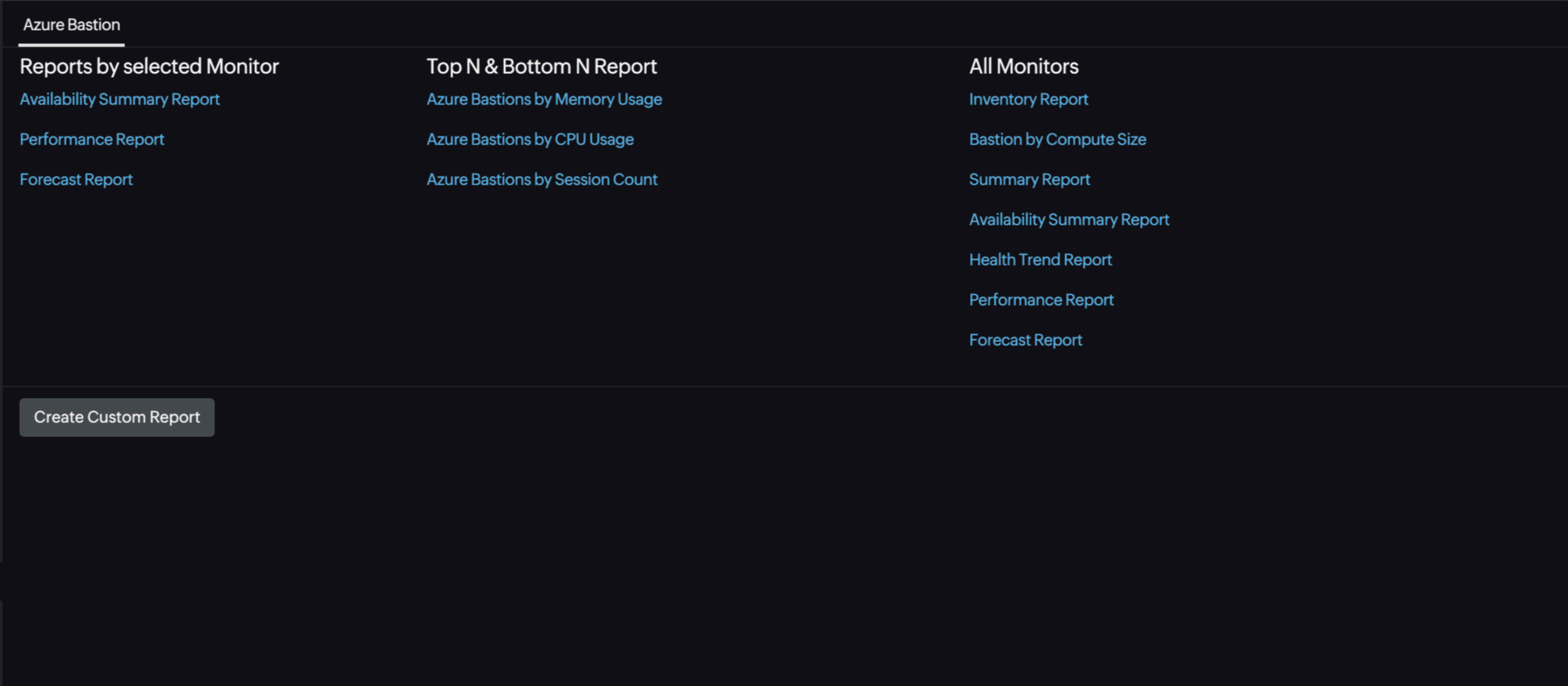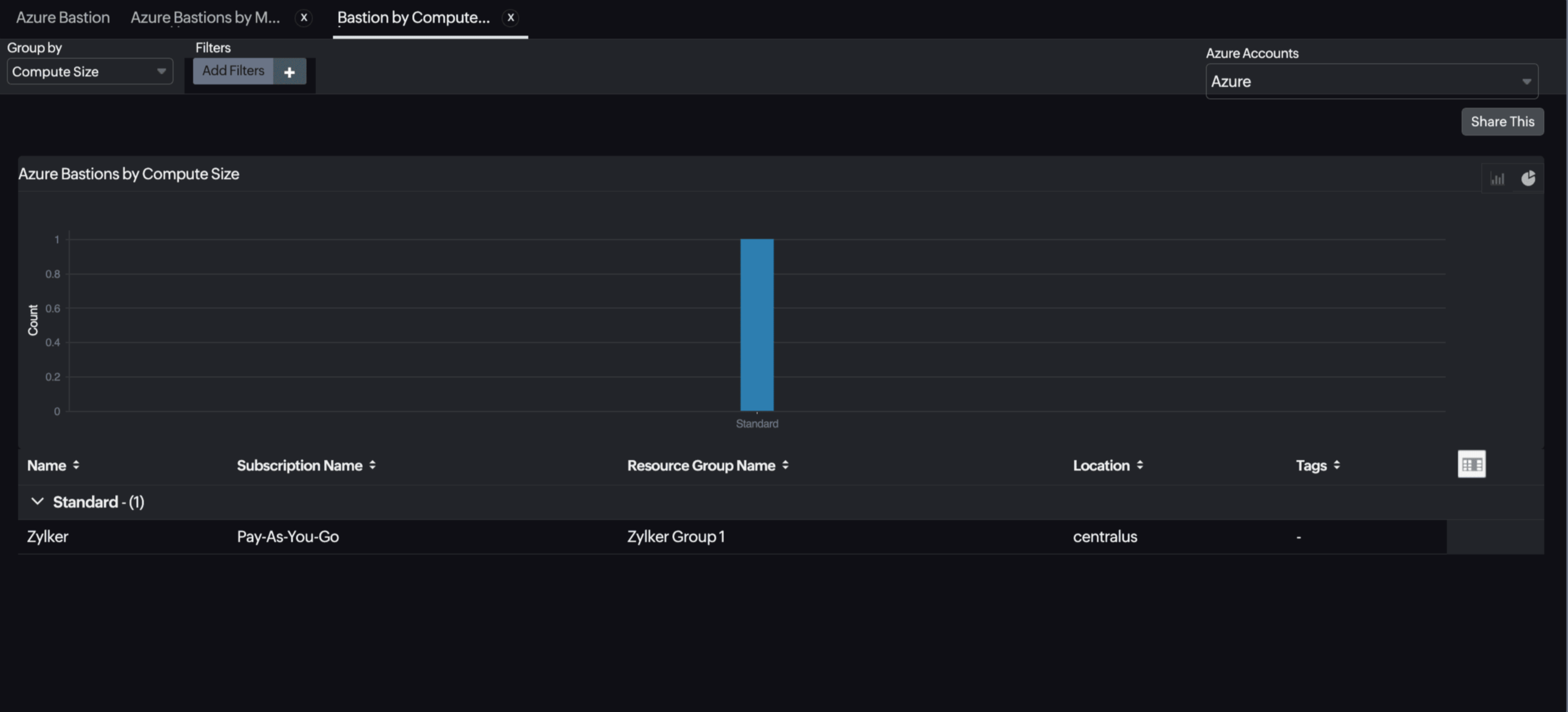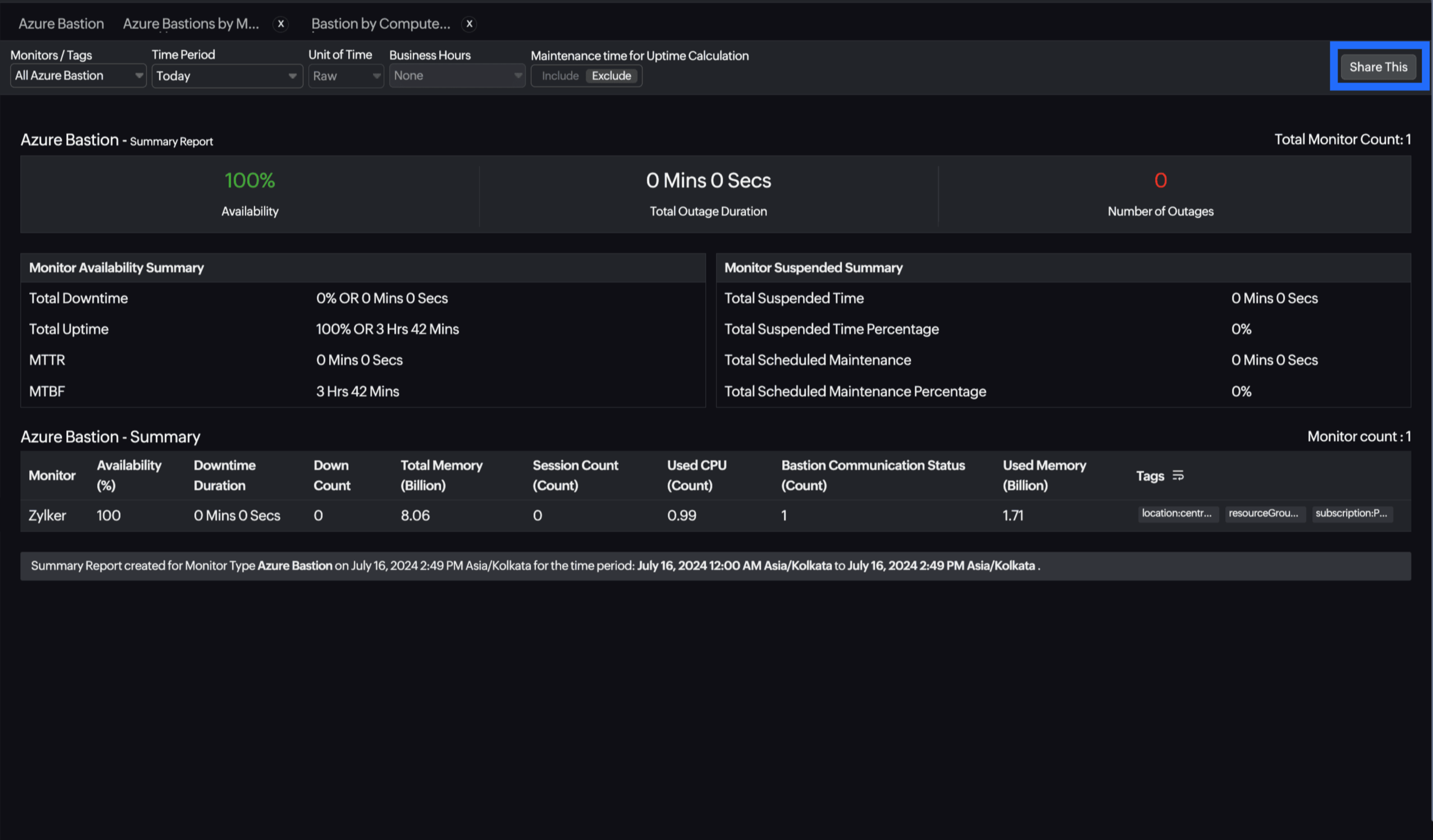Monitor Azure Bastion
Azure Bastion acts as a critical jump server for production and development environments.
Using Site24x7 to monitor Bastion host performance is essential to avoid connectivity issues and prevent overload. Site24x7's continuous monitoring ensures the Bastion host remains available and operational, minimizing downtime and providing reliable access to VMs.
Setup and configuration
Adding Azure Bastion while configuring a new Azure monitor
If you haven't configured an Azure monitor yet, or if you're setting one up for the first time, follow the steps below to add an Azure monitor along with an Azure Bastion monitor:
- Log in to your Site24x7 account.
- Choose Cloud from the left navigation pane, and select Azure > Add Azure Monitor. You can also follow these steps to add an Azure monitor.
- During Azure monitor configuration, on the Add Azure Monitor page, select Azure Bastion along with other required resource types from the Service/Resource Types drop-down. Check if you have configured the corresponding resource groups and tag filters in the Edit page.
Adding Azure Bastion to an existing Azure monitor
If you already have an Azure monitor configured for the tenant, you can add Azure Bastion using the following steps:
- Log in to your Site24x7 account.
- Navigate to Cloud > Azure and select the Azure monitor from the left pane for which you wish to add Azure Bastion.
- On the Service View page, click the Enable Monitoring button for the Azure Bastion service type. Check if you have configured the corresponding resource groups and tag filters in the Edit page.
It will take 15-30 minutes to discover new Azure resources. To immediately discover the selected configuration, click Discover Now in the top-right corner, and all the resources that match the filters configured on the Azure Edit page will be discovered even if the Auto-Discover New Resources option is disabled.
Now you can view the discovered resources from the Service View dashboard itself.
Polling frequency
Site24x7's Azure Bastion monitor collects metric data every minute and the statuses from your applications every five minutes.
Supported metrics
Forecasted metrics are denoted as (FM).
| Metric name | Description | Statistic | Unit |
|---|---|---|---|
| Bastion Communication Status (FM) | The status of the Bastion communication: The communication status shows 1 if the communication is good and 0 if it is bad | Average | Count |
| Session Count (FM) | The total number of sessions for the Bastion host | Total | Count |
| Total Memory (FM) | The total memory stats (billion) | Average | Count |
| CPU Usage (FM) | The average CPU usage stats | Average | Count |
| Memory Usage (FM) | The average memory usage stats (billion) | Average | Count |
Threshold configuration
Associating a threshold profile can be done from the monitor's Edit page:
- Under Configuration Profiles > Threshold and Availability > select the corresponding threshold profile from the drop-down.
The changes made to this threshold profile will be applied to all the associated monitors. You can either add or edit a threshold profile by clicking the + or pencil icon, respectively.
Bulk Action
Bulk association of threshold profiles can be done from the Admin page (Admin > Inventory > Bulk Action > under Monitor Configuration, go to Modify Threshold Profile).
You can set threshold values for the metrics by selecting the Threshold and Availability option. You can also configure IT automation at the attribute level.
Default thresholds
Site24x7 alerts you based on a set of default thresholds. These default thresholds ensure that your service capacity is not overutilized, thus maintaining optimal storage and performance and reducing costs.
These are the default thresholds:
- Resource Health
- On Change Configuration
- Metrics threshold
Resource Health:
- Alert if Resource Health is Unavailable
- Alert if Resource Health is Unknown
On Change Configuration:
- Alert if Compute Size is Changed
- Alert if Scale Unit is Changed
- Alert if Tunneling Status is Changed
- Alert if IP Connection Status is Changed
- Alert if Copy Paste Status is Changed
- Alert if Shareable Link Status is Changed
- Alert if Kerberos Status is Changed
Metrics threshold:
- Bastion Communication Status
- Used CPU
IT automation
Site24x7 offers a set of exclusive IT automation tools to auto-resolve performance degradation issues. These tools react to events proactively rather than waiting for manual intervention.
How to configure IT automation for a monitor
Configuration Rules
With Site24x7's Configuration Rules, you can set parameters like Threshold Profile, Notification Profile, Tags, and Monitor Group for multiple monitors. These rules can be configured and run for the existing or new monitors (during addition) matching the given criteria.
How to add a configuration rule
Reports
Gain in-depth data about the various parameters of your monitored resources and accentuate your service performance using our insightful reports.
To view reports for Azure Bastion:
- Navigate to the Reports section in the left navigation pane.
- Select Azure Bastion from the menu on the left.

You can find the Availability Summary Report and Performance Report for one selected monitor, or you can get the Inventory Report, Summary Report, Availability Summary Report, Health Trend Report, Bastion by Compute Size Report, and Performance Report for all the monitors. Apart from this, you can view the Top N and Bottom N Reports.
Bastion by Compute Size report:
Site24x7's Azure Bastion monitoring also provides a Bastion by Compute Size report that will enable you to gain deep insights into your resources.

Top N and Bottom N reports
- Azure Bastions by Memory Usage
- Azure Bastions by CPU Usage
- Azure Bastions by Session Count

To schedule a report:
You can schedule the Inventory Report by navigating to Reports > Azure Bastion > Inventory Report and clicking the Share This button at the top-right corner.
In the Schedule Report pop-up, choose the monitor, assign the desired frequency—daily, weekly, monthly, or quarterly—and send regular reports on your inventory details to the groups that you desire.

You can also view the reports from the Performance tab of the Azure Bastion monitor.
- Go to the Performance tab of the Azure Bastion monitor, and get the Availability Summary Report of the monitor by clicking Availability.
- You can also find the Performance Report of the monitor by clicking any chart title.
Site24x7's Bastion monitoring interface
Get an overview of the availability and usage status of your Bastion host.
Performance
The Performance tab helps you view performance data, including the memory and CPU usage of your resource as well as its availability status.
Configuration Details
The Configuration Details tab provides the configuration details of your Bastion host. Details on the compute site, DNS, the status of the Kerberos, IP configurations, tunneling, and more are included in this section.
Sessions
With the Sessions tab, you can view the number and the status of the sessions.
Zia Forecast
By leveraging the AI-driven Zia framework, you can examine resource consumption measurements through the forecast chart located in the Zia Forecast tab. This chart predicts upcoming performance metrics based on a seven-day historical data analysis, providing insights into the expected metric usage for the next seven days.
Outages
The Outages tab provides the history of the Bastion statuses, including Down, Trouble, and Critical.
Inventory
The Inventory tab provides details on licensing, threshold and availability profiles, the set notification profiles, the set user alert group, and the monitor's created time and modified time.
Log Report
The Log Report tab lists all the logs collected during every data collection along with their statuses.
